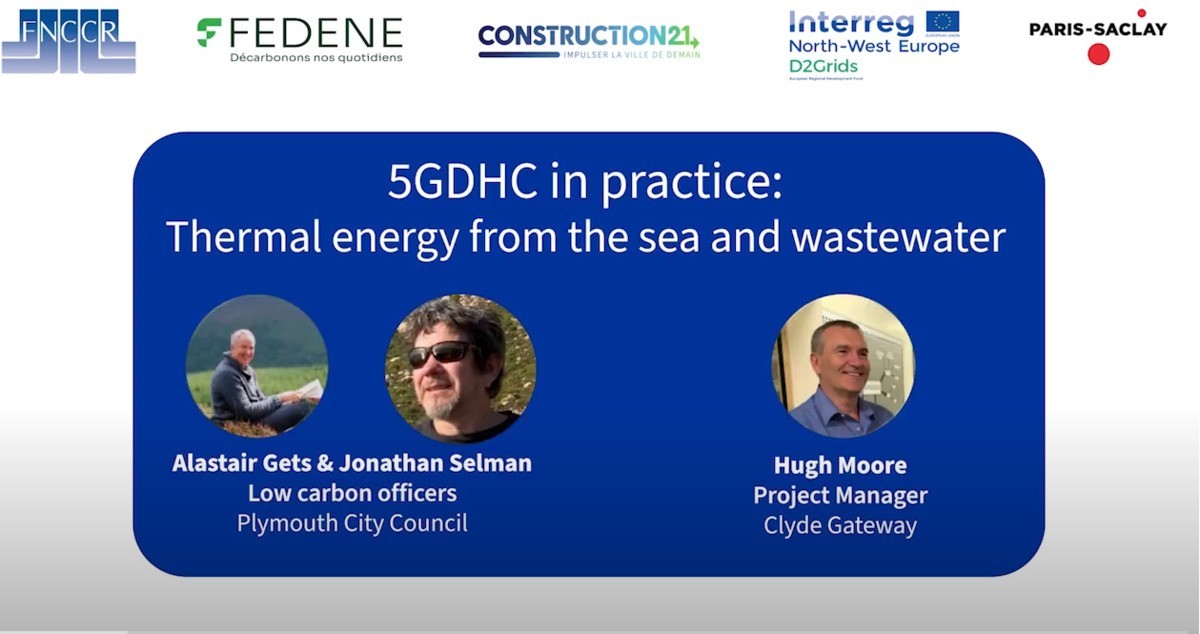5GDHC in practice: Thermal energy from the sea and wastewater

Jonathan Selman, low carbon officer at Plymouth City Council, and Hugh Moore, project manager at Clyde Gateway, presented their cities' pioneering approaches to fifth generation heating and cooling grids during D2Grids final conference on April 19th, 2023.
Plymouth heating and cooling grid
Plymouth, one of the five pilot sites of the D2Grids European project, is a coastal city surrounded by the sea on three sides. At the recent D2Grids final conference, Jonathan Selman shed light on Plymouth's innovative approach to heating and cooling, emphasizing the city's utilization of local resources in a smart and productive manner.
The primary energy source for heating and cooling in Plymouth is the sea, but in an “unusual and highly effective fashion”, as Jonathan mentions. Leveraging existing geothermal wells that were once used for public baths and new ones, Plymouth is implementing a technique known as consumptive abstraction. This process involves drawing water out from a geothermal source and returning the saline water back into the sea after utilization.
The city is willing to expand and develop new geothermal solutions over time. By embracing this innovative system, Plymouth not only aims to meet the high demand for heating and cooling in its city centre but also to establish a blueprint for other coastal cities facing similar challenges.
Additionally, solar PV panels play a crucial role in the grid's operations. Existing buildings are interconnected through a private wire network, which allows for the integration of solar energy generation. By maximizing rooftop space, additional solar capacity is installed, providing renewable electricity to power the heat pumps during certain periods of the year. This integration of solar power reduces costs and carbon footprints, making the grid more sustainable and economically viable.
Furthermore, Plymouth's commitment to sustainable energy is evident in its plans for future expansion. The city council is developing a solar farm on a former waste site, further increasing the solar capacity, and reinforcing their renewable energy goals. Additionally, the exploration of a virtual private wire system allows the city to optimize the use of its electricity resources, ensuring efficient energy distribution to its buildings.
Find out more in this case study!
Glasgow heating and cooling grid
Hugh Moore presented Glasgow pilot site, which focuses on wastewater as a primary resource. The Scottish pilot site is the result of the collaboration between Clyde Gateway and Scottish Water Horizons.
The Dalmarnock Renewable Heat Project lies at the heart of Glasgow's heating and cooling grid. This energy centre initiative revolves around the concept of using wastewater, specifically sewage, for heat recovery.
Through the innovative Energy Centre, the city leverages this abundant resource to generate low-carbon heat for a 5th generation district heating and cooling grid.
The key objective of the Dalmarnock Renewable Heat Project is to create a symbiotic relationship between wastewater management and energy generation. By capturing and processing wastewater, Glasgow not only addresses environmental concerns but also meets the heating and cooling demands of various buildings within the Magenta Business Park site. The wastewater, carefully filtered and treated, flows through a grid of plastic pipeline, following a predefined path to reach the energy centre.
Once the wastewater treated reaches the energy centre, heat pumps come into play, extracting, and amplifying the recovered heat. This process elevates the temperature of the tempered water, allowing it to serve as a reliable and sustainable heat source for the site. However, the system can also cool the water, facilitating effective cooling solutions for buildings connected to the grid.
The impact of Glasgow's heating and cooling grid extends beyond the Magenta Business Park site. Local businesses, homes, supermarkets, schools, and sports facilities in the area all stand to benefit from this innovative energy solution. Being connected to the 5GDHC grid not only provides ecological advantages but also economic benefits for both companies and residents.
Find out about it in details in this case study!
paul.capgras[a]construction21.fr




